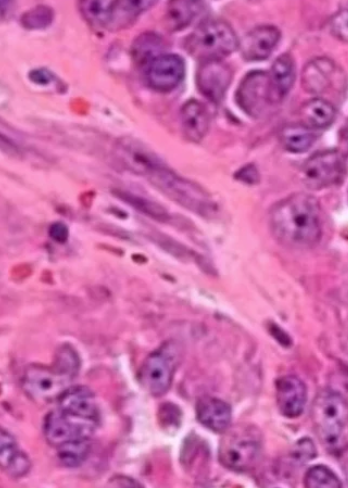Article
High-Grade Surface Osteosarcoma Exhibits Poor Oncologic Outcomes
Author(s):
The survival outcomes of patients with high-grade surface osteosarcoma is poor, despite the use of contemporary treatment with surgery and chemotherapy.

The survival outcomes of patients with high-grade surface osteosarcoma is poor, despite the use of contemporary treatment with surgery and chemotherapy, according to a retrospective analysis published in the Journal of Bone Oncology.
The estimated 3- and 5-year overall survival (OS) rates were 67.7% and 37.6%, respectively. In addition, no significant difference in OS was found with regard to age, gender, anatomic location (diaphysis or metaphysis), marrow involvement of the lesion, surgical margin, or use of neoadjuvant chemotherapy.
High-grade surface osteosarcoma is an extremely rare subtype of osteosarcoma, treatment for which varies from center to center.
“Compared to patients with conventional osteosarcoma treated in our center, the survival rate was much lower because of the higher metastasis rate in high-grade surface osteosarcoma, with the use of the same chemotherapy regimen for both patient groups,” lead study author Zhiping Deng, MD, of Peking University, and co-authors wrote.
Clinical, radiological, and histological parameters were used to assess patient survival. The study population consisted of 23 patients who had been treated at the Beijing Jishuitan Hospital between 1992 and 2015; 16 patients were male and 7 were female. The median age was 24 years (range, 14-57).
Three patients treated before 2000 were excluded from the survival analysis. In 2 patients, the follow-up durations were only 3 and 7 months before they were lost to follow-up. In the third patient, the follow-up time was sufficient but characterized treatment that was no longer considered standard after 2000.
All patients presented with pain and swelling of the affected limb; the median duration of symptoms was 6 months (range, 3-8). All of these cases occurred in the lower limb: proximal femur (n = 1), femoral diaphysis (n = 6), distal femur (n = 8), proximal tibia (n = 3), tibial diaphysis (n = 4) and distal fibula (n = 1).
All patients underwent preoperative CT scans, and all but 1 underwent a preoperative MRI scan. All tumors involved the lower limb and were located at the diaphysis in 11 patients and at the metaphysis in 12 patients. Although the majority of tumors were located at the surface of the bone, the medullary canal was involved in 10 patients. The radiologic studies displayed aggressive features in all cases, including bone destruction, periosteal reaction, and a soft tissue component.
All specimens were sectioned longitudinally and axially using an electric saw. Medullary canal involvement was evaluated macroscopically. The microscopic findings were indistinguishable from conventional central osteosarcoma. All patients were treated with a combination of surgery and chemotherapy, which comprised high-dose methotrexate, ifosfamide, doxorubicin, and cisplatin.
Follow-up data were completed in 20 patients, the median duration of which ranged from 27 months to 182 months, or until death (range, 5-104). Of the 20 patients, 12 died of the disease, and 8 patients were alive at the time of the last follow-up.
With regard to chemotherapy, 6 patients received neoadjuvant and adjuvant chemotherapy, while 14 patients received only adjuvant chemotherapy. Additionally, 4 patients underwent amputation, whereas the remaining 16 patients (80%) underwent limb-sparing surgery. Two patients presented with lung metastasis (stage III), and the others had only local disease at diagnosis (stage IIB).
Wide surgical margins were achieved in 15 patients, and marginal margins were achieved in 5 patients. Local recurrence occurred at 13 months in 2 patients who had initially undergone resections with marginal margins. No local recurrence occurred in patients whose tumors had been resected with wide margins. The local recurrence rates for wide and marginal margins were 0% and 40%, respectively, suggesting that a wide surgical margin is essential for local control of the tumor.
“In some patients, the soft tissue mass is very large and close to the neurovascular bundle. Preservation of the neurovascular bundle necessitates a marginal margin on the neurovascular bundle for limb salvage, which may increase the risk of local recurrence,” wrote the authors.
Additional findings demonstrated that the high distant metastasis rate in high-grade osteosarcoma is a significant contributor to poor survival outcomes. A total of 13 patients who achieved wide surgical margins developed lung metastasis, and 1 patient developed cervical spine metastasis. Twelve patients died of metastasis, and the other 2 patients were still alive following resection of lung metastasis. The total local recurrence rate was 10% (n = 2), and the distant metastasis rate was 70% (n = 14).
Of note, lung metastasis at diagnosis (stage III) was associated with a worse OS compared with stage IIB cases (P < .01). Distant metastasis was also associated with a worse OS versus localized disease (P < .01).
In the 18 patients who presented without metastasis, no difference in survival was reported in those who received neoadjuvant and adjuvant chemotherapy compared with patients who received only adjuvant chemotherapy (P = .94).
“Investigations into improving chemotherapy is crucial for this disease,” concluded the authors.
Reference
- Deng Z, Huang Z, Ding Y, et al. High-grade surface osteosarcoma: clinical features and oncologic outcome. J Bone Oncol. 2020;23(100288). doi.org/10.1016/j.jbo.2020.100288









